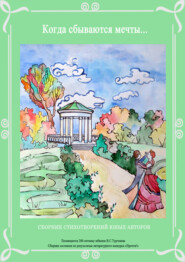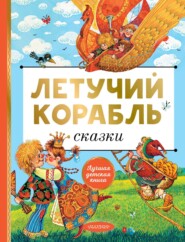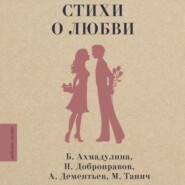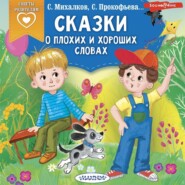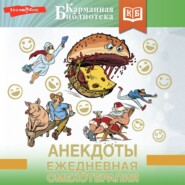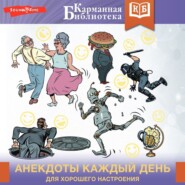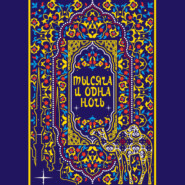По всем вопросам обращайтесь на: info@litportal.ru
(©) 2003-2024.
✖
Storytelling. The adventure of the three students and other stories
Настройки чтения
Размер шрифта
Высота строк
Поля
Storytelling. The adventure of the three students and other stories
Collection
Юлия Вадимовна Белочкина
Folio World’s Classics
The storytelling method is the study of language with the help of short stories. Stories help to practice grammar and vocabulary, promote imagination, speaking, listening, and writing. This technique is perfect for different age groups, children, as well as teenagers, and adults.
The book contains stories by Arthur Conan Doyle, Joseph Rudyard Kipling, Jack London, W. H. Hudson, Louisa May Alcott, Saki, Dinah Mulock Craik, Maria Edgeworth, Gilbert Keith Chesterton for middle school students.
The publishing layout has been saved in PDF A4 format.
Сборник
Storytelling. The adventure of the three students and other stories
© Yu. Belochkina, compiling, 2021
© O. Huhalova-Mieshkova, graphic artist, 2021
© Folio Publishing House, brand series, 2020
The Bull
by Saki
Tom Yorkfield had always regarded his half-brother, Laurence, with a lazy instinct of dislike, toned down, as years went on, to a tolerant feeling of indifference. There was nothing very tangible to dislike him for; he was just a blood-relation, with whom Tom had no single taste or interest in common, and with whom, at the same time, he had had no occasion for quarrel. Laurence had left the farm early in life, and had lived for a few years on a small sum of money left him by his mother; he had taken up painting as a profession, and was reported to be doing fairly well at it, well enough, at any rate, to keep body and soul together. He specialised in painting animals, and he was successful in finding a certain number of people to buy his pictures. Tom felt a comforting sense of assured superiority in contrasting his position with that of his half-brother; Laurence was an artist-chap, just that and nothing more, though you might make it sound more important by calling him an animal painter; Tom was a farmer, not in a very big way, it was true, but the Helsery farm had been in the family for some generations, and it had a good reputation for the stock raised on it. Tom had done his best, with the little capital at his command, to maintain and improve the standard of his small herd of cattle, and in Clover Fairy he had bred a bull which was something rather better than any that his immediate neighbours could show. It would not have made a sensation in the judging-ring at an important cattle show, but it was as vigorous, shapely, and healthy a young animal as any small practical farmer could wish to possess. At the King’s Head on market days Clover Fairy was very highly spoken of, and Yorkfield used to declare that he would not part with him for a hundred pounds; a hundred pounds is a lot of money in the small farming line, and probably anything over eighty would have tempted him.
It was with some especial pleasure that Tom took advantage of one of Laurence’s rare visits to the farm to lead him down to the enclosure where Clover Fairy kept solitary state – the grass widower of a grazing harem. Tom felt some of his old dislike for his half-brother reviving; the artist was becoming more languid in his manner, more unsuitably turned-out in attire, and he seemed inclined to impart a slightly patronising tone to his conversation. He took no heed of a flourishing potato crop, but waxed enthusiastic over a clump of yellow-flowering weed that stood in a corner by a gateway, which was rather galling to the owner of a really very well weeded farm; again, when he might have been duly complimentary about a group of fat, black-faced lambs, that simply cried aloud for admiration, he became eloquent over the foliage tints of an oak copse on the hill opposite. But now he was being taken to inspect the crowning pride and glory of Helsery; however grudging he might be in his praises, however backward and niggardly with his congratulations, he would have to see and acknowledge the many excellences of that redoubtable animal. Some weeks ago, while on a business journey to Taunton, Tom had been invited by his half-brother to visit a studio in that town, where Laurence was exhibiting one of his pictures, a large canvas representing a bull standing knee-deep in some marshy ground; it had been good of its kind, no doubt, and Laurence had seemed inordinately pleased with it; “the best thing I’ve done yet,” he had said over and over again, and Tom had generously agreed that it was fairly life-like. Now, the man of pigments was going to be shown a real picture, a living model of strength and comeliness, a thing to feast the eyes on, a picture that exhibited new pose and action with every shifting minute, instead of standing glued into one unvarying attitude between the four walls of a frame. Tom unfastened a stout wooden door and led the way into a straw-bedded yard.
“Is he quiet?” asked the artist, as a young bull with a curly red coat came inquiringly towards them.
“He’s playful at times,” said Tom, leaving his half-brother to wonder whether the bull’s ideas of play were of the catch-as-catch-can order. Laurence made one or two perfunctory comments on the animal’s appearance and asked a question or so as to his age and such-like details; then he coolly turned the talk into another channel.
“Do you remember the picture I showed you at Taunton?” he asked.
“Yes,” grunted Tom; “a white-faced bull standing in some slush. Don’t admire those Herefords much myself; bulky-looking brutes, don’t seem to have much life in them. Daresay they’re easier to paint that way; now, this young beggar is on the move all the time, aren’t you, Fairy?”
“I’ve sold that picture,” said Laurence, with considerable complacency in his voice.
“Have you?” said Tom; “glad to hear it, I’m sure. Hope you’re pleased with what you’ve got for it.”
“I got three hundred pounds for it,” said Laurence.
Tom turned towards him with a slowly rising flush of anger in his face. Three hundred pounds! Under the most favourable market conditions that he could imagine his prized Clover Fairy would hardly fetch a hundred, yet here was a piece of varnished canvas, painted by his half-brother, selling for three times that sum. It was a cruel insult that went home with all the more force because it emphasised the triumph of the patronising, self-satisfied Laurence. The young farmer had meant to put his relative just a little out of conceit with himself by displaying the jewel of his possessions, and now the tables were turned, and his valued beast was made to look cheap and insignificant beside the price paid for a mere picture. It was so monstrously unjust; the painting would never be anything more than a dexterous piece of counterfeit life, while Clover Fairy was the real thing, a monarch in his little world, a personality in the countryside. After he was dead, even, he would still be something of a personality; his descendants would graze in those valley meadows and hillside pastures, they would fill stall and byre and milking-shed, their good red coats would speckle the landscape and crowd the market-place; men would note a promising heifer or a well-proportioned steer, and say: “Ah, that one comes of good old Clover Fairy’s stock.” All that time the picture would be hanging, lifeless and unchanging, beneath its dust and varnish, a chattel that ceased to mean anything if you chose to turn it with its back to the wall. These thoughts chased themselves angrily through Tom Yorkfield’s mind, but he could not put them into words. When he gave tongue to his feelings he put matters bluntly and harshly.
“Some soft-witted fools may like to throw away three hundred pounds on a bit of paintwork; can’t say as I envy them their taste. I’d rather have the real thing than a picture of it.”
He nodded towards the young bull, that was alternately staring at them with nose held high and lowering its horns with a half-playful, half-impatient shake of the head.
Laurence laughed a laugh of irritating, indulgent amusement.
“I don’t think the purchaser of my bit of paintwork, as you call it, need worry about having thrown his money away. As I get to be better known and recognised my pictures will go up in value. That particular one will probably fetch four hundred in a sale-room five or six years hence; pictures aren’t a bad investment if you know enough to pick out the work of the right men. Now you can’t say your precious bull is going to get more valuable the longer you keep him; he’ll have his little day, and then, if you go on keeping him, he’ll come down at last to a few shillingsworth of hoofs and hide, just at a time, perhaps, when my bull is being bought for a big sum for some important picture gallery.”
It was too much. The united force of truth and slander and insult put over heavy a strain on Tom Yorkfield’s powers of restraint. In his right hand he held a useful oak cudgel, with his left he made a grab at the loose collar of Laurence’s canary-coloured silk shirt. Laurence was not a fighting man; the fear of physical violence threw him off his balance as completely as overmastering indignation had thrown Tom off his, and thus it came to pass that Clover Fairy was regaled with the unprecedented sight of a human being scudding and squawking across the enclosure, like the hen that would persist in trying to establish a nesting-place in the manger. In another crowded happy moment the bull was trying to jerk Laurence over his left shoulder, to prod him in the ribs while still in the air, and to kneel on him when he reached the ground. It was only the vigorous intervention of Tom that induced him to relinquish the last item of his programme.
Tom devotedly and ungrudgingly nursed his half brother to a complete recovery from his injuries, which consisted of nothing more serious than a dislocated shoulder, a broken rib or two, and a little nervous prostration. After all, there was no further occasion for rancour in the young farmer’s mind; Laurence’s bull might sell for three hundred, or for six hundred, and be admired by thousands in some big picture gallery, but it would never toss a man over one shoulder and catch him a jab in the ribs before he had fallen on the other side. That was Clover Fairy’s noteworthy achievement, which could never be taken away from him.
Laurence continues to be popular as an animal artist, but his subjects are always kittens or fawns or lambkins – never bulls.
Chris Farrington: able seaman
by Jack London
“If you vas in der old country ships, a liddle shaver like you vood pe only der boy, und you vood wait on der able seamen. Und ven der able seaman sing out, ‘Boy, der water-jug!’ you vood jump quick, like a shot, und bring der water-jug. Und ven der able seaman sing out, ‘Boy, my boots!’ you vood get der boots. Und you vood pe politeful, und say ‘Yessir’ und ‘No sir.’ But you pe in der American ship, und you t’ink you are so good as der able seamen. Chris, mine boy, I haf ben a sailorman for twenty-two years, und do you t’ink you are so good as me? I vas a sailorman peforeyou vas borned, und I knot und reef und splice ven you play mittopstrings und fly kites.”
“But you are unfair, Emil!” cried Chris Farrington, his sensitive face flushed and hurt. He was a slender though strongly built young fellow of seventeen, with Yankee ancestry writ large all over him.
“Dere you go vonce again!” the Swedish sailor exploded. “My name is Mister Johansen, und a kid of a boy like you call me ‘Emil!’ It vas insulting, und comes pecause of der American ship!”
“But you call me ‘Chris!’” the boy expostulated, reproachfully.
“But you vas a boy.”
“Who does a man’s work,” Chris retorted. “And because I do a man’s work I have as much right to call you by your first name as you me. We are all equals in this fo’castle, and you know it. When we signed for the voyage in San Francisco, we signed as sailors on the Sophie Sutherland and there was no difference made with any of us. Haven’t I always done my work? Did I ever shirk? Did you or any other man ever have to take a wheel for me? Or a lookout? Or go aloft?”
“Chris is right,” interrupted a young English sailor. “No man has had to do a tap of his work yet. He signed as good as any of us, and he’s shown himself as good – ”
“Better!” broke in a Nova Scotia man. “Better than some of us! When we struck the sealing-grounds he turned out to be next to the best boat-steerer aboard. Only French Louis, who’d been at it for years, could beat him. I’m only a boat-puller, and you’re only a boat-puller, too, Emil Johansen, for all your twenty-two years at sea. Why don’t you become a boat-steerer?”
“Too clumsy,” laughed the Englishman, “and too slow.”
“Little that counts, one way or the other,” joined in Dane Jurgensen, coming to the aid of his Scandinavian brother. “Emil is a man grown and an able seaman; the boy is neither.”
And so the argument raged back and forth, the Swedes, Norwegians and Danes, because of race kinship, taking the part of Johansen, and the English, Canadians and Americans taking the part of Chris. From an unprejudiced point of view, the right was on the side of Chris. As he had truly said, he did a man’s work, and the same work that any of them did. But they were prejudiced, and badly so, and out of the words which passed rose a standing quarrel which divided the forecastle into two parties.
The Sophie Sutherland was a seal-hunter, registered out of San Francisco, and engaged in hunting the furry sea-animals along the Japanese coast north to Bering Sea. The other vessels were two-masted schooners, but she was a three-master and the largest in the fleet. In fact, she was a full-rigged, three-topmast schooner, newly built.
Although Chris Farrington knew that justice was with him, and that he performed all his work faithfully and well, many a time, in secret thought, he longed for some pressing emergency to arise whereby he could demonstrate to the Scandinavian seamen that he also was an able seaman.
But one stormy night, by an accident for which he was in nowise accountable, in overhauling a spare anchor-chain he had all the fingers of his left hand badly crushed. And his hopes were likewise crushed, for it was impossible for him to continue hunting with the boats, and he was forced to stay idly aboard until his fingers should heal. Yet, although he little dreamed it, this very accident was to give him the long-looked-for opportunity.
One afternoon in the latter part of May the Sophie Sutherland rolled sluggishly in a breathless calm. The seals were abundant, the hunting good, and the boats were all away and out of sight. And with them was almost every man of the crew. Besides Chris, there remained only the captain, the sailing-master and the Chinese cook.
The captain was captain only by courtesy. He was an old man, past eighty, and blissfully ignorant of the sea and its ways; but he was the owner of the vessel, and hence the honorable title. Of course the sailing-master, who was really captain, was a thorough-going seaman. The mate, whose post was aboard, was out with the boats, having temporarily taken Chris’s place as boat-steerer.
When good weather and good sport came together, the boats were accustomed to range far and wide, and often did not return to the schooner until long after dark. But for all that it was a perfect hunting day, Chris noted a growing anxiety on the part of the sailing-master. He paced the deck nervously, and was constantly sweeping the horizon with his marine glasses. Not a boat was in sight. As sunset arrived, he even sent Chris aloft to the mizzen-topmast-head, but with no better luck. The boats could not possibly be back before midnight.
Since noon the barometer had been falling with startling rapidity, and all the signs were ripe for a great storm – how great, not even the sailing-master anticipated. He and Chris set to work to prepare for it. They put storm gaskets on the furled topsails, lowered and stowed the foresail and spanker and took in the two inner jibs. In the one remaining jib they put a single reef, and a single reef in the mainsail.
Collection
Юлия Вадимовна Белочкина
Folio World’s Classics
The storytelling method is the study of language with the help of short stories. Stories help to practice grammar and vocabulary, promote imagination, speaking, listening, and writing. This technique is perfect for different age groups, children, as well as teenagers, and adults.
The book contains stories by Arthur Conan Doyle, Joseph Rudyard Kipling, Jack London, W. H. Hudson, Louisa May Alcott, Saki, Dinah Mulock Craik, Maria Edgeworth, Gilbert Keith Chesterton for middle school students.
The publishing layout has been saved in PDF A4 format.
Сборник
Storytelling. The adventure of the three students and other stories
© Yu. Belochkina, compiling, 2021
© O. Huhalova-Mieshkova, graphic artist, 2021
© Folio Publishing House, brand series, 2020
The Bull
by Saki
Tom Yorkfield had always regarded his half-brother, Laurence, with a lazy instinct of dislike, toned down, as years went on, to a tolerant feeling of indifference. There was nothing very tangible to dislike him for; he was just a blood-relation, with whom Tom had no single taste or interest in common, and with whom, at the same time, he had had no occasion for quarrel. Laurence had left the farm early in life, and had lived for a few years on a small sum of money left him by his mother; he had taken up painting as a profession, and was reported to be doing fairly well at it, well enough, at any rate, to keep body and soul together. He specialised in painting animals, and he was successful in finding a certain number of people to buy his pictures. Tom felt a comforting sense of assured superiority in contrasting his position with that of his half-brother; Laurence was an artist-chap, just that and nothing more, though you might make it sound more important by calling him an animal painter; Tom was a farmer, not in a very big way, it was true, but the Helsery farm had been in the family for some generations, and it had a good reputation for the stock raised on it. Tom had done his best, with the little capital at his command, to maintain and improve the standard of his small herd of cattle, and in Clover Fairy he had bred a bull which was something rather better than any that his immediate neighbours could show. It would not have made a sensation in the judging-ring at an important cattle show, but it was as vigorous, shapely, and healthy a young animal as any small practical farmer could wish to possess. At the King’s Head on market days Clover Fairy was very highly spoken of, and Yorkfield used to declare that he would not part with him for a hundred pounds; a hundred pounds is a lot of money in the small farming line, and probably anything over eighty would have tempted him.
It was with some especial pleasure that Tom took advantage of one of Laurence’s rare visits to the farm to lead him down to the enclosure where Clover Fairy kept solitary state – the grass widower of a grazing harem. Tom felt some of his old dislike for his half-brother reviving; the artist was becoming more languid in his manner, more unsuitably turned-out in attire, and he seemed inclined to impart a slightly patronising tone to his conversation. He took no heed of a flourishing potato crop, but waxed enthusiastic over a clump of yellow-flowering weed that stood in a corner by a gateway, which was rather galling to the owner of a really very well weeded farm; again, when he might have been duly complimentary about a group of fat, black-faced lambs, that simply cried aloud for admiration, he became eloquent over the foliage tints of an oak copse on the hill opposite. But now he was being taken to inspect the crowning pride and glory of Helsery; however grudging he might be in his praises, however backward and niggardly with his congratulations, he would have to see and acknowledge the many excellences of that redoubtable animal. Some weeks ago, while on a business journey to Taunton, Tom had been invited by his half-brother to visit a studio in that town, where Laurence was exhibiting one of his pictures, a large canvas representing a bull standing knee-deep in some marshy ground; it had been good of its kind, no doubt, and Laurence had seemed inordinately pleased with it; “the best thing I’ve done yet,” he had said over and over again, and Tom had generously agreed that it was fairly life-like. Now, the man of pigments was going to be shown a real picture, a living model of strength and comeliness, a thing to feast the eyes on, a picture that exhibited new pose and action with every shifting minute, instead of standing glued into one unvarying attitude between the four walls of a frame. Tom unfastened a stout wooden door and led the way into a straw-bedded yard.
“Is he quiet?” asked the artist, as a young bull with a curly red coat came inquiringly towards them.
“He’s playful at times,” said Tom, leaving his half-brother to wonder whether the bull’s ideas of play were of the catch-as-catch-can order. Laurence made one or two perfunctory comments on the animal’s appearance and asked a question or so as to his age and such-like details; then he coolly turned the talk into another channel.
“Do you remember the picture I showed you at Taunton?” he asked.
“Yes,” grunted Tom; “a white-faced bull standing in some slush. Don’t admire those Herefords much myself; bulky-looking brutes, don’t seem to have much life in them. Daresay they’re easier to paint that way; now, this young beggar is on the move all the time, aren’t you, Fairy?”
“I’ve sold that picture,” said Laurence, with considerable complacency in his voice.
“Have you?” said Tom; “glad to hear it, I’m sure. Hope you’re pleased with what you’ve got for it.”
“I got three hundred pounds for it,” said Laurence.
Tom turned towards him with a slowly rising flush of anger in his face. Three hundred pounds! Under the most favourable market conditions that he could imagine his prized Clover Fairy would hardly fetch a hundred, yet here was a piece of varnished canvas, painted by his half-brother, selling for three times that sum. It was a cruel insult that went home with all the more force because it emphasised the triumph of the patronising, self-satisfied Laurence. The young farmer had meant to put his relative just a little out of conceit with himself by displaying the jewel of his possessions, and now the tables were turned, and his valued beast was made to look cheap and insignificant beside the price paid for a mere picture. It was so monstrously unjust; the painting would never be anything more than a dexterous piece of counterfeit life, while Clover Fairy was the real thing, a monarch in his little world, a personality in the countryside. After he was dead, even, he would still be something of a personality; his descendants would graze in those valley meadows and hillside pastures, they would fill stall and byre and milking-shed, their good red coats would speckle the landscape and crowd the market-place; men would note a promising heifer or a well-proportioned steer, and say: “Ah, that one comes of good old Clover Fairy’s stock.” All that time the picture would be hanging, lifeless and unchanging, beneath its dust and varnish, a chattel that ceased to mean anything if you chose to turn it with its back to the wall. These thoughts chased themselves angrily through Tom Yorkfield’s mind, but he could not put them into words. When he gave tongue to his feelings he put matters bluntly and harshly.
“Some soft-witted fools may like to throw away three hundred pounds on a bit of paintwork; can’t say as I envy them their taste. I’d rather have the real thing than a picture of it.”
He nodded towards the young bull, that was alternately staring at them with nose held high and lowering its horns with a half-playful, half-impatient shake of the head.
Laurence laughed a laugh of irritating, indulgent amusement.
“I don’t think the purchaser of my bit of paintwork, as you call it, need worry about having thrown his money away. As I get to be better known and recognised my pictures will go up in value. That particular one will probably fetch four hundred in a sale-room five or six years hence; pictures aren’t a bad investment if you know enough to pick out the work of the right men. Now you can’t say your precious bull is going to get more valuable the longer you keep him; he’ll have his little day, and then, if you go on keeping him, he’ll come down at last to a few shillingsworth of hoofs and hide, just at a time, perhaps, when my bull is being bought for a big sum for some important picture gallery.”
It was too much. The united force of truth and slander and insult put over heavy a strain on Tom Yorkfield’s powers of restraint. In his right hand he held a useful oak cudgel, with his left he made a grab at the loose collar of Laurence’s canary-coloured silk shirt. Laurence was not a fighting man; the fear of physical violence threw him off his balance as completely as overmastering indignation had thrown Tom off his, and thus it came to pass that Clover Fairy was regaled with the unprecedented sight of a human being scudding and squawking across the enclosure, like the hen that would persist in trying to establish a nesting-place in the manger. In another crowded happy moment the bull was trying to jerk Laurence over his left shoulder, to prod him in the ribs while still in the air, and to kneel on him when he reached the ground. It was only the vigorous intervention of Tom that induced him to relinquish the last item of his programme.
Tom devotedly and ungrudgingly nursed his half brother to a complete recovery from his injuries, which consisted of nothing more serious than a dislocated shoulder, a broken rib or two, and a little nervous prostration. After all, there was no further occasion for rancour in the young farmer’s mind; Laurence’s bull might sell for three hundred, or for six hundred, and be admired by thousands in some big picture gallery, but it would never toss a man over one shoulder and catch him a jab in the ribs before he had fallen on the other side. That was Clover Fairy’s noteworthy achievement, which could never be taken away from him.
Laurence continues to be popular as an animal artist, but his subjects are always kittens or fawns or lambkins – never bulls.
Chris Farrington: able seaman
by Jack London
“If you vas in der old country ships, a liddle shaver like you vood pe only der boy, und you vood wait on der able seamen. Und ven der able seaman sing out, ‘Boy, der water-jug!’ you vood jump quick, like a shot, und bring der water-jug. Und ven der able seaman sing out, ‘Boy, my boots!’ you vood get der boots. Und you vood pe politeful, und say ‘Yessir’ und ‘No sir.’ But you pe in der American ship, und you t’ink you are so good as der able seamen. Chris, mine boy, I haf ben a sailorman for twenty-two years, und do you t’ink you are so good as me? I vas a sailorman peforeyou vas borned, und I knot und reef und splice ven you play mittopstrings und fly kites.”
“But you are unfair, Emil!” cried Chris Farrington, his sensitive face flushed and hurt. He was a slender though strongly built young fellow of seventeen, with Yankee ancestry writ large all over him.
“Dere you go vonce again!” the Swedish sailor exploded. “My name is Mister Johansen, und a kid of a boy like you call me ‘Emil!’ It vas insulting, und comes pecause of der American ship!”
“But you call me ‘Chris!’” the boy expostulated, reproachfully.
“But you vas a boy.”
“Who does a man’s work,” Chris retorted. “And because I do a man’s work I have as much right to call you by your first name as you me. We are all equals in this fo’castle, and you know it. When we signed for the voyage in San Francisco, we signed as sailors on the Sophie Sutherland and there was no difference made with any of us. Haven’t I always done my work? Did I ever shirk? Did you or any other man ever have to take a wheel for me? Or a lookout? Or go aloft?”
“Chris is right,” interrupted a young English sailor. “No man has had to do a tap of his work yet. He signed as good as any of us, and he’s shown himself as good – ”
“Better!” broke in a Nova Scotia man. “Better than some of us! When we struck the sealing-grounds he turned out to be next to the best boat-steerer aboard. Only French Louis, who’d been at it for years, could beat him. I’m only a boat-puller, and you’re only a boat-puller, too, Emil Johansen, for all your twenty-two years at sea. Why don’t you become a boat-steerer?”
“Too clumsy,” laughed the Englishman, “and too slow.”
“Little that counts, one way or the other,” joined in Dane Jurgensen, coming to the aid of his Scandinavian brother. “Emil is a man grown and an able seaman; the boy is neither.”
And so the argument raged back and forth, the Swedes, Norwegians and Danes, because of race kinship, taking the part of Johansen, and the English, Canadians and Americans taking the part of Chris. From an unprejudiced point of view, the right was on the side of Chris. As he had truly said, he did a man’s work, and the same work that any of them did. But they were prejudiced, and badly so, and out of the words which passed rose a standing quarrel which divided the forecastle into two parties.
The Sophie Sutherland was a seal-hunter, registered out of San Francisco, and engaged in hunting the furry sea-animals along the Japanese coast north to Bering Sea. The other vessels were two-masted schooners, but she was a three-master and the largest in the fleet. In fact, she was a full-rigged, three-topmast schooner, newly built.
Although Chris Farrington knew that justice was with him, and that he performed all his work faithfully and well, many a time, in secret thought, he longed for some pressing emergency to arise whereby he could demonstrate to the Scandinavian seamen that he also was an able seaman.
But one stormy night, by an accident for which he was in nowise accountable, in overhauling a spare anchor-chain he had all the fingers of his left hand badly crushed. And his hopes were likewise crushed, for it was impossible for him to continue hunting with the boats, and he was forced to stay idly aboard until his fingers should heal. Yet, although he little dreamed it, this very accident was to give him the long-looked-for opportunity.
One afternoon in the latter part of May the Sophie Sutherland rolled sluggishly in a breathless calm. The seals were abundant, the hunting good, and the boats were all away and out of sight. And with them was almost every man of the crew. Besides Chris, there remained only the captain, the sailing-master and the Chinese cook.
The captain was captain only by courtesy. He was an old man, past eighty, and blissfully ignorant of the sea and its ways; but he was the owner of the vessel, and hence the honorable title. Of course the sailing-master, who was really captain, was a thorough-going seaman. The mate, whose post was aboard, was out with the boats, having temporarily taken Chris’s place as boat-steerer.
When good weather and good sport came together, the boats were accustomed to range far and wide, and often did not return to the schooner until long after dark. But for all that it was a perfect hunting day, Chris noted a growing anxiety on the part of the sailing-master. He paced the deck nervously, and was constantly sweeping the horizon with his marine glasses. Not a boat was in sight. As sunset arrived, he even sent Chris aloft to the mizzen-topmast-head, but with no better luck. The boats could not possibly be back before midnight.
Since noon the barometer had been falling with startling rapidity, and all the signs were ripe for a great storm – how great, not even the sailing-master anticipated. He and Chris set to work to prepare for it. They put storm gaskets on the furled topsails, lowered and stowed the foresail and spanker and took in the two inner jibs. In the one remaining jib they put a single reef, and a single reef in the mainsail.






